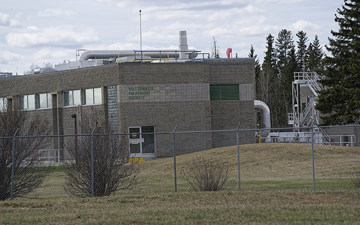Less infrastructure funding leaves municipalities with tough decisions

Under a new funding formula, Alberta municipalities are receiving less funding from the provincial government than they did in 2011, leading to potential tax hikes
GRAND PRARIE, May 9, 2024 – Local municipalities are grappling with rising infrastructure costs and less cash from the province.
The province is handing out about $4 million less to local municipalities in 2024 than it did in 2011.
“If we had the same infrastructure funding as we had back in 2011, then that's a huge property tax decrease we could have,” said Dylan Bressey, Alberta Municipalities (ABMunis) director of cities up to 500,000 and city councillor.
Cuts to infrastructure funding have left municipalities with few choices such as raising local taxes or allowing critical infrastructure to deteriorate.
The province funds infrastructure such as roads, bridges, public transit vehicles and facilities, water and wastewater, and municipal buildings for recreation and sports.
In 2024, the City of Grande Prairie received about $1.7 million less than it did in 2011.
Other local municipalities have also seen funding cuts compared to the 2011 funding levels: County of Grande Prairie -$1.4 million, Saddle Hills County -$694,600, Town of Beaverlodge -$13,200, and Town of Wembley -$86,400.
“All municipalities are struggling, just because the base funding amount is so low that it really is having an impact on everyone,” said Bressey.
The province began its new funding formula for municipalities this year. The Local Government Funding Framework (LGFF) replaces the Municipal Sustainability Initiative (MSI) formula.
The province allotted $724 million to LGFF this year, but ABMunis says it should be around $1.75 billion.
“It's about a billion dollars short of where it should be; it's less than half of what MSI used to be funded, and the impact of that has been that municipalities are having to choose between allowing their infrastructure to crumble or drastically raising their property taxes,” said Bressey. “$1.75 billion, it's not just a number we pulled out of nowhere; it is justified; it's about half the cost that municipalities are seeing every year to depreciate their assets and build new assets.
“It's less than we'd be receiving if MSI had kept up with population plus inflation growth,” he said.
According to ABmunis, in 2011 the province provided about $424 per capita for infrastructure; in 2023 it was $154 per capita.
“Municipalities, on the whole, have taken a decrease in funding,” said Sexsmith Mayor Kate Potter.
She said Sexsmith is only now getting back to similar funding levels from 2011. The town received $499,000 in 2011; in 2024 it was allocated $535,000.
Potter said that since 2011 Sexsmith has seen population growth, the cost of goods increase, and the town take on additional costs such as policing due to the province's police funding model.
Physician attraction and retention is an additional cost, the mayor said.
“Because Sexsmith doesn't have an AHS facility, AHS doesn't recruit physicians for our community; it's up to us to make sure that we have or that we're working with the local physicians to make sure that they are fully staffed,” said Potter.
“We've worked really hard to try and keep fairly stable taxes, and we've cut in a lot of areas, so we're always looking at money-saving efforts,” she said, noting that the council is currently exploring different cost-saving measures, such as cutting the council size.
Additionally, local shareholders of Aquatera — the City of Grande Prairie, the County of Grande Prairie, and the towns of Sexsmith and Wembley — collectively believe they are missing about $700,000 in infrastructure funding because LGFF does not recognize their water and wastewater assets because the municipally controlled corporation owns them.
“Because we don't directly own it, we're not getting credit for it,” said City of Grande Prairie Mayor Jackie Clayton.
She said most other municipalities receive credit for their systems and more funding for their municipality under the LGFF formula.
LGFF has enabled some municipalities to plan the future better.
“The provincial government of the day heard on a regular basis from municipalities that they wanted consistent and predictable funding,” said Clayton.
Bressey said LGFF uses a predictable formula so municipalities can look ahead.
Additionally, LGFF is also tied to provincial revenues, so if the province gains more revenue, so do municipalities. However, if revenue is down, municipalities don’t receive additional funding.
“I really appreciate that one-to-one growth model for revenue increases, but the reality is that we're working with a lot less than we have historically, and when the cost is rising so much, that really ends up affecting our residents more than anything else,” said Potter.
Jesse Boily is a Local Journalism Initiative reporter with Town & Country News in the Grand Prarie Region of Alberta. Title Image: The Aquatera water and wastewater facility in Grande Prairie, Alta. on Monday, May 6, 2024 (photo by Jesse Boily).










(0) Comments